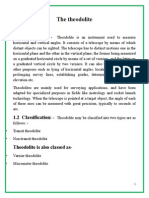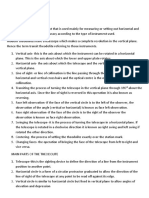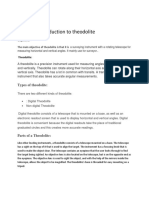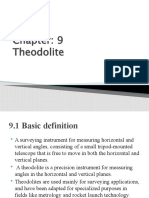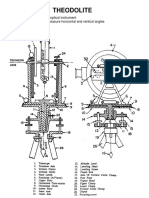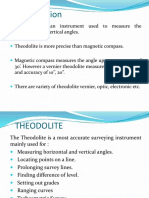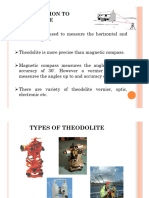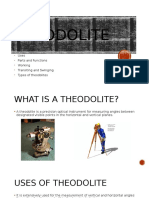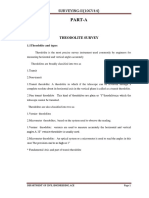Theodolite 1
Uploaded by
GaggiTheodolite 1
Uploaded by
GaggiUNIVERSITY OF DUHOK
COLLEGE OF ENGINEERING
CIVIL DEPARTMENT-
ENGINEERING SURVEYING
STUDY OF THEODOLITE
BY
STUDENT NAME: GORGEES A. KAWRASH
GROUP: A
SUPERVISOR
“MR. AGEED”
EXPERIMNET NO.: 1
EXPERIMENT DATE: FEBRUARY 15, 2023
Table of Contents
1 Introduction ................................................................................ 2
2 Objectives .................................................................................. 3
3 Uses of Theodolite: ...................................................................... 3
4 Types of Theodolite ..................................................................... 4
5 Main parts of Theodolite ............................................................... 5
6 Technical terms used in Theodolite ................................................ 7
7 Temporary adjustment: ............................................................... 8
8 Setting up a Theodolite above the point ........................................10
9 References ................................................................................12
1
1 Introduction
Theodolite may be defined as the optical survey instrument that is used to
measure the angles between the specified points both in the vertical and
horizontal plane.
In other words, theodolite may be defined as the instrument fitted with a
small telescope that can move freely in the horizontal and vertical plane to
measure the horizontal and vertical angles in surveying.
It is widely used in traversing, land surveying and other infrastructure
construction.
2
2 Objectives
To study different parts of Theodolite and temporary adjustments.
3 Uses of Theodolite:
1. It is used to measure the horizontal and vertical angles.
2. It is used to locate points on a line.
3. It is used to prolong the survey lines.
4. it is used to range the curves.
5. It is also used to measure slopes.
6. It is used in Tachometric surveying.
3
4 Types of Theodolite
1. Transit Theodolite: The line of the sight in a transit theodolite
can be reversed if the telescope is reversed through 180° in a
vertical plane.
2. Non-Transit Theodolites: They are also known as Y-theodolites
and plane theodolites. In such types of theodolites, the reversal of
sight line and telescope is not possible.
3. Digital Theodolite: The values of the observation are provided
directly on the viewing panel of the digital theodolite. The precision
of a digital theodolite varies in order of 1” to 10”.
4. Vernier Theodolite: It is the most commonly used theodolite, in
which the principles of a Vernier Caliper are utilized while taking
out observations. The precision values of this type of instrument
vary in the order of 10" to 20".
5. Total station Theodolite: This is a modern electronic instrument.
All the parameters can be obtained which are required to be
observed in the survey procedure. The viewing panel of the
instrument displays the observation values. The precision of this
type of instrument ranges in the order of 0.1" to 10".
4
5 Main parts of Theodolite
5
1. Base plate
2. Spring plate
3. Leveling screw
4. Tribrach clamp
5. Leveling screw
6. Circle setting knob
7. Reflector for collimation level
8. Tangent screw for latitude
9. Level prism
10. Eyepiece
11. Clamping screw for vertical circle
12. Illuminating mirror for vertical circle
13. Illuminating mirror for Diaphragm
14. Center point and bead
15. Vertical circle casing
16. Objective lens
17. Front sight
18. Optical micrometer knob
19. Bearing ring
20. Focussing ring
21. Eyepiece for reading telescope
22. Inverter knob
23. Plate level
24. Tangent screw for Azimuth
25. Electric light socket
26. Retaining stop
27. Illuminating mirror for horizontal circle
28. tribrach
6
6 Technical terms used in Theodolite
1-Telescope: It consists of eye-piece, object glass and focusing screw and
it is used to sight the object.
2-Vertical Circle: It is used to measure vertical angles.
3-Levelling Head: It consists of two parallel triangular plates called
tribrach plates. Its uses are: 1) To support the main part of the instrument,
2) To attach the theodolite to the tripod.
4-Lower Plate: It consists of lower clamp screw and tangent screw.
5-Upper Plate: The upper plate is attached to the inner axis and it carries
two verniers. It consists of an upper clamp screw and tangent screws. These
screws are used to fix upper plate with lower plate accurately.
6-Plumb Bob: It is used to center theodolite exactly over the ground
station mark.
7-Swinging The Telescope: It means turning the telescope about its
vertical axis in the horizontal plane. A swing is called right or left according
as the telescope is rotated clockwise or counter clockwise.
8-Face Left: If face of the vertical circle is to the left side of the observer,
then the observation of the angles taken is known as face left observation.
9-Face Right: If the face of the vertical circle is to the right side of the
observation, then the observation of the angles taken is known as face right
observation.
10-Changing Face: It is an operation of bringing the face of the telescope
from left to right and vice-versa.
Note: Face left and face right are the terms used in optical theodolite, While
Direct mode and Reverse mode terms are used in the digital theodolite.
7
7 Temporary adjustment:
The adjustments which are carried out at every setting of the instrument
before the observations are referred as temporary adjustments. There are
three types of temporary adjustments as follows.
1. Setting up.
2. Levelling up.
3. Elimination of parallax.
1. Setting up
This adjustment includes the following two operations.
A. Centering the Theodolite over the instrument station.
B. Approximate leveling of Theodolite with the help of the tripod legs only.
A. Centering.
It is the operation by which the vertical axis of the theodolite represented
by a plumb line is made to pass through the mark of instrument station on
the ground.
B. Approximate leveling
The approximate leveling may be done with the reference to a small circular
bubble provided on the tribrach or by eye judgements
2. Levelling up
The operation of making the vertical axis truly vertical is known as leveling
of the Theodolite. After the centering and approximate leveling an accurate
leveling is to be done with the help of foot screws
2. Levelling up
I. First the telescope is to be kept parallel to any of the two foot screws
as in the figure.
8
II. The bubble of plate level is to be brought to the centre of its run by
turning the foot screws either inwards or outwards simultaneously.
III. Then the telescope is to be turned through 90°, so that it lies over
the third foot screw (i.e perpendicular to the first position).
IV. The bubble is to be brought to the centre of its run by turning the
third foot screw either clockwise or anticlockwise
V. If the bubble is not in centre the above operations are repeated till
the bubble retain at centre in both the positions.
3. Elimination of parallax
An apparent change in the position of an object caused by the change in
position of the observer’s eye is known as parallax. This can be eliminated
in two steps.
1. Focusing the eye piece for distinct vision of the cross hairs
2. Focusing the objective to bring the image of the object in the plane
of cross hairs.
1. Focusing the eye piece
▪ The telescope is to be pointed towards the sky or a sheet of white
paper is to be hold in front of the objective.
▪ The eye piece is to be moved in or out by rotating it gradually until
the appearance of cross hairs becomes sharp and distinct.
2. Focusing the objective
▪ Telescope is to be directed towards the object.
▪ Focusing screw is to be turned until the appearance of the object
becomes sharp and clear.
9
8 Setting up a Theodolite above the point
1- Set up the tripod
Setup the tripod first: extend the extension legs to suitable lengths and
tighten the screws on the mid sections. Make sure the legs are spaced at
equal intervals and the head is approximately level. Set the tripod so that
the head is positioned over the surveying point. Make sure the tripod legs
are firmly fixed in the ground.
2- Mount the instrument on the tripod head
a) Mount the instrument on the tripod head. Supporting it with one
hand, tighten the centering screw on the bottom of the unit to make sure
it is secured to the tripod.
b) Turn on the instrument, Pressto open “Direction” light (Only for
laser theodolite), Pressagain to open laser “Point”, we can see the red
laser to the ground out from the base down. Through the laser we can
adjust the position of the tripod point observation. So that the next point
roughly aims at the station, make all three legs are fixed on the ground.
Adjust the instrument three foot spiral to the point precisely to the
measurement site.
3- Centering and Leveling-Up
a) Position tripod legs so that the plummet is aimed to the ground
mark point. Turn the focusing ring of the optical (Laser) plummet to focus.
b) Turn three foot screws of the tribrach till the center of reticle exactly
coincides with the surveying point in any position.
10
c) Move the tripod legs to centre the circular level. The instrument is
now roughly leveled-up.
4. Center the bubble in the circular level.
a) Loosen the horizontal motion clamp, and turn the instrument till the
plate level is perpendicular to a line shaped with screws A and B.
Adjust the screws A and B to make the bubble in the center of the level.
b) Turn the instrument approximately 90º , adjust screw C till the
bubble in the center of the level. Repeat the above steps until the bubble
remains in the center of the plate level while the instrument is rotated to
any position.
5. Center the surveying point again
Loosen the centering screw slightly. Looking through the optical (Laser)
plummet eyepiece, slide the instrument over the tripod head until the
surveying point is exactly centered in the reticle. Re-tighten the centering
screw securely.
6. Check
check again to make sure the bubble in the plate level is centered. If not,
repeat procedure 4.
11
9 References
1. https:///topics/labreports
2. https:///typesoftheodolite/
3. https:///engineeringsurveyng
12
You might also like
- Theodolite, Traverse and Omitted MeasurementsNo ratings yetTheodolite, Traverse and Omitted Measurements9 pages
- Parts of Theodolite and Their FunctionsNo ratings yetParts of Theodolite and Their Functions11 pages
- Lecture 2 Cive 321 Angular and Distance Measurements Week 2 2022No ratings yetLecture 2 Cive 321 Angular and Distance Measurements Week 2 202260 pages
- Theodolite: Uses Parts and Functions Working Transiting and Swinging Types of TheodolitesNo ratings yetTheodolite: Uses Parts and Functions Working Transiting and Swinging Types of Theodolites10 pages
- Government Polytechnic College Muttom: Laboratory Manual Survey Practical-IiNo ratings yetGovernment Polytechnic College Muttom: Laboratory Manual Survey Practical-Ii38 pages
- 1.theodolite - Introduction, Parts, Terms, ClassificationNo ratings yet1.theodolite - Introduction, Parts, Terms, Classification27 pages
- .+ ... Wse05101 Topographic Surveying Lecture Notes Chapter One TheodoliteNo ratings yet.+ ... Wse05101 Topographic Surveying Lecture Notes Chapter One Theodolite12 pages
- Survey Camp Presentation On Theodolite SurveyingNo ratings yetSurvey Camp Presentation On Theodolite Surveying37 pages
- L1 Permanent Adjustment of Theodolites and LevelsNo ratings yetL1 Permanent Adjustment of Theodolites and Levels32 pages
- SUT 171 Fundamentals of Surveying Unit # 4 "Measurement of Angles"No ratings yetSUT 171 Fundamentals of Surveying Unit # 4 "Measurement of Angles"7 pages
- Theodolite:: Mr. Momin Umarfarook H. (B.E Civil, M.E StructureNo ratings yetTheodolite:: Mr. Momin Umarfarook H. (B.E Civil, M.E Structure52 pages
- THE THEODOLITEAND INTRODUCTION TO COORDINATESNo ratings yetTHE THEODOLITEAND INTRODUCTION TO COORDINATES25 pages
- ADVANCED MINE SURVEYING - NOTES - 22377 - FINAL YEAR - MININGNo ratings yetADVANCED MINE SURVEYING - NOTES - 22377 - FINAL YEAR - MINING49 pages
- Sun and Earth Modern User Reference Guide: Determining earth’s true surface shape as flat using the sunFrom EverandSun and Earth Modern User Reference Guide: Determining earth’s true surface shape as flat using the sunNo ratings yet
- Assignment-1_eeb50bfecf3add7a034960f7596c951f_241021_220238No ratings yetAssignment-1_eeb50bfecf3add7a034960f7596c951f_241021_2202381 page
- Data Sheet Modulus of Rupture of Tile: Test No.: 4 Student Name: Group No.: Date of TestingNo ratings yetData Sheet Modulus of Rupture of Tile: Test No.: 4 Student Name: Group No.: Date of Testing1 page
- Waukesha Cherry Burrell Sshe Votator Origin Series Bro GBNo ratings yetWaukesha Cherry Burrell Sshe Votator Origin Series Bro GB8 pages
- Indian Coast Guard: Directorate of Recruitment67% (3)Indian Coast Guard: Directorate of Recruitment6 pages
- دور إدارة المعرفة في التقليل من آثار المخاطر-دراسة-نظريةNo ratings yetدور إدارة المعرفة في التقليل من آثار المخاطر-دراسة-نظرية23 pages
- Docmaster: Uncontrolled Copy When Printed (109720)No ratings yetDocmaster: Uncontrolled Copy When Printed (109720)16 pages
- 1.introduction To Flexible Drives & BeltsNo ratings yet1.introduction To Flexible Drives & Belts17 pages
- Barter Systems, Trading What You Have For What You WantNo ratings yetBarter Systems, Trading What You Have For What You Want2 pages
- Key Benefits:: Reduce MTTR With Automatic Threat RemediationNo ratings yetKey Benefits:: Reduce MTTR With Automatic Threat Remediation2 pages
- The Development of An Automated Irrigation System Using An Open Source MicrocontrollerNo ratings yetThe Development of An Automated Irrigation System Using An Open Source Microcontroller8 pages
- Blended Learning Across Disciplines Ichsan PDFNo ratings yetBlended Learning Across Disciplines Ichsan PDF305 pages
- Commercial Photography Contract Free Download in PDFNo ratings yetCommercial Photography Contract Free Download in PDF3 pages




